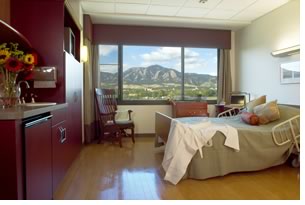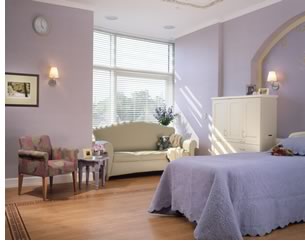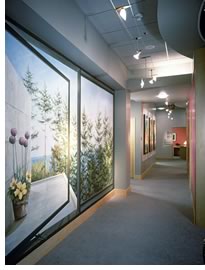

02/2005
The text and recommendations presented here are excerpted from the Center for Health Design (CHD) study, “The Role of the Physical Environment in the Hospital of the 21st Century: A Once-in-a-Lifetime Opportunity.”
Medical errors and hospital-acquired infections are among the leading causes of death in the U.S., each killing more Americans than AIDS, breast cancer, or automobile accidents. Just as medicine has increasingly moved toward “evidence-based medicine,” where clinical choices are informed by research, health-care design is increasingly guided by rigorous research linking the physical environment of hospitals to patients and staff outcomes and is moving toward “evidence-based design.”
In this project, research teams from Texas A&M University and Georgia Tech combed through several thousand scientific articles and identified more than 600 studies—most in top peer-reviewed journals—that establish how hospital design can affect clinical outcomes. The research team found rigorous studies that link the physical environment to patient and staff outcomes in four areas:
- Reduced staff stress and fatigue and increased effectiveness in delivering care
- Improved patient safety
- Reduced stress and improved outcomes
- Improved overall health-care quality.
Reduced Staff Stress and Fatigue and Increased Effectiveness in Delivering Care
 Registered nurses in the U.S. are, on average, more than 43 years
old and will average 50 by 2010 and have a turnover rate averaging 20
percent per year. The Joint Commission on Accreditation of Healthcare
Organizations (JCAHO), in their 2002 report, Health
Care at the Crossroads: Strategies for Addressing the Evolving Nursing
Crisis, noted that a shortage
of nurses in America’s hospitals is putting patient lives in danger.
The JCAHO report and surveys of nursing found that physical working conditions,
along with support and compensation, are key contributors to turnover
and burnout. Environmental support for work has become more critical
as the typical patient is more seriously ill, patient loads increase,
technology changes, and documentation requirements increase.
Registered nurses in the U.S. are, on average, more than 43 years
old and will average 50 by 2010 and have a turnover rate averaging 20
percent per year. The Joint Commission on Accreditation of Healthcare
Organizations (JCAHO), in their 2002 report, Health
Care at the Crossroads: Strategies for Addressing the Evolving Nursing
Crisis, noted that a shortage
of nurses in America’s hospitals is putting patient lives in danger.
The JCAHO report and surveys of nursing found that physical working conditions,
along with support and compensation, are key contributors to turnover
and burnout. Environmental support for work has become more critical
as the typical patient is more seriously ill, patient loads increase,
technology changes, and documentation requirements increase.
Good ventilation: Nurses, physicians, and other health-care employees work under extremely stressful physical conditions. Several studies deal with health-care employees’ risk of contracting infectious diseases from patients due to airborne and surface contamination. A recent study conducted in the wake of the SARS epidemic in China found that isolating SARS cases in wards with good ventilation could reduce the viral load of the ward and might be the key to preventing outbreaks of SARS among health-care workers, along with strict personal protection measures in isolation units.
Another study in Norway found correlations between environmental factors and nasal symptoms of 115 females who worked at 36 geriatric nursing departments. They found significant decrease in nasal inflammation in relation to presence of Aspergillus fumigatus (fungus spores) in ventilation supply and elevated room temperatures. An evaluation of 17 acute-care or university hospitals in Canada shows that tuberculosis (TB) infection among health-care workers was associated with ventilation of general or non-isolation patient rooms of less than two air exchanges per hour. This study, like the others, supports the importance of adequate ventilation with good maintenance for ensuring both staff and patient safety in hospitals.
 Noise: Many research studies have examined the effects of noise on patients,
but comparatively few studies are available for health-care staff. There
is evidence that staff perceive higher sound levels as stressful. Importantly,
noise-induced stress in nurses correlates with reported emotional exhaustion
or burnout. A recent study by Blomkvist et al. (in press, 2004) examined
the effects of higher versus lower noise levels on the same group of
coronary intensive-care nurses over a period of months. Lower noise levels
were linked with a number of positive effects on staff, including reduced
perceived work demands, increased workplace social support, improved
quality of care for patients, and better speech intelligibility.
Noise: Many research studies have examined the effects of noise on patients,
but comparatively few studies are available for health-care staff. There
is evidence that staff perceive higher sound levels as stressful. Importantly,
noise-induced stress in nurses correlates with reported emotional exhaustion
or burnout. A recent study by Blomkvist et al. (in press, 2004) examined
the effects of higher versus lower noise levels on the same group of
coronary intensive-care nurses over a period of months. Lower noise levels
were linked with a number of positive effects on staff, including reduced
perceived work demands, increased workplace social support, improved
quality of care for patients, and better speech intelligibility.
Walking distance: Nurses spend a lot of time walking. At least four studies have shown that the type of unit layout (e.g., radial, single corridor, double corridor) influences the amount of walking among nursing staff, and two studies showed that time saved walking was translated into more time spent on patient-care activities and interaction with family members. Workplace design that reflects a closer alignment of work patterns and the physical setting, such as redesign of a pharmacy layout, has been shown to improve work flow and reduce waiting times, as well as increase patient satisfaction with the service.
Improved Patient Safety
Transmission of infection to patients occurs through two general routes: airborne and contact. The literature suggests a clear pattern wherein infection rates are lower when there is very good air quality and patients are in single-bed rather than multi-bed rooms. Also, there is some evidence that providing numerous, easily accessible alcohol-based hand-rub dispensers or hand-washing sinks can increase hand washing compliance and thereby reduce contact contamination.
Air quality: Evidence from many studies leaves no doubt that hospital air quality and ventilation play decisive roles in affecting air concentrations of pathogens such as Aspergillus and, in this way, have major effects on infection rates. Well-conducted research has linked all of the following to air quality and infection rates: type of air filter, direction of airflow and air pressure, air changes per hour in room, humidity, and ventilation system cleaning and maintenance. Several studies have identified hospital construction and renovation activities as the sources of airborne infection outbreaks due to dust or particulate generation.
 There is convincing evidence that immuno-compromised and other high-acuity
patient groups have lower incidence of infection when housed in a HEPA-filtered
isolation room. Air contamination is least in laminar airflow rooms with
HEPA filters, and this approach is recommended for operating-room suites
and areas with ultraclean room requirements such as those housing immuno-compromised
patient populations. (Laminar flows are very even, smooth, low velocity
airflows that are used in cleanrooms and other settings where high quality
ventilation is critical. But laminar flows are relatively expensive and
difficult to achieve because furnishings, vents, and other features can
create turbulence.)
There is convincing evidence that immuno-compromised and other high-acuity
patient groups have lower incidence of infection when housed in a HEPA-filtered
isolation room. Air contamination is least in laminar airflow rooms with
HEPA filters, and this approach is recommended for operating-room suites
and areas with ultraclean room requirements such as those housing immuno-compromised
patient populations. (Laminar flows are very even, smooth, low velocity
airflows that are used in cleanrooms and other settings where high quality
ventilation is critical. But laminar flows are relatively expensive and
difficult to achieve because furnishings, vents, and other features can
create turbulence.)
Sustained hand-washing: Although infection caused by airborne transmission poses a major safety problem, most infections are now acquired in the hospital via the contact pathway. It is well-established that the hands of health-care staff are the principal cause of contact transmission from patient to patient. Given the tremendous morbidity and mortality associated with high rates of hospital-acquired infections, there is an urgent need to identify more effective ways for producing sustained increases in hand washing.
The research team identified six studies that examined whether hand washing is improved by increasing the ratio of the number of sinks of hand-cleaner dispensers to beds and/or by placing sinks of hand-cleaner dispensers in more accessible locations. In particular, the evidence suggests that installing alcohol-based hand-cleaner dispensers at bedside usually improves adherence. Two other investigations focusing on sinks (water/soap) identified a positive relationship between observed frequency of hand washing and a higher ratio of sinks to beds. Further, three studies offer convincing and important evidence that providing single-patient rooms with a conveniently located sink in each room reduces nosocomial infection rates in intensive care units, such as neonatal intensive care (NICU) or burn units, compared to when the same staff and comparable patients are in multi-bed open units with few sinks.
Single- vs. multi-bed rooms: The research team identified at least 16 studies relevant to the question of whether nosocomial infection rates differ between single-bed and multi-bed rooms. The findings collectively provide a strong pattern of evidence indicating that infection rates are usually lower in single-bed rooms. One clear set of advantages relates to reducing airborne transmission through air quality and ventilation measures such as HEPA filters, negative room pressure to prevent a patient with an aerial-spread infection from infecting others, or maintaining positive pressure to protect an immuno-compromised patient from airborne pathogens in nearby rooms. In addition to clear advantages in reducing airborne transmission, several studies show that single-bed rooms also lessen risk of infections acquired by contact. Compared to single-bed rooms, multi-bed rooms are far more difficult to decontaminate thoroughly after a patient is discharged, and therefore worsen the problem of multiple surfaces acting as pathogen reservoirs.
Reduced Stress and Improved Outcomes
 World Health Organization guideline values for continuous background
noise in hospital patient rooms are 35dB, with nighttime peaks in wards
not to exceed 40dB. These guidelines notwithstanding, many studies
have shown that hospital background noise levels fall in far higher
ranges. Background noise levels typically are 45-68dB, with peaks frequently
exceeding 85-90dB. The research reviewed suggests that hospitals are
excessively noisy for two general reasons. First, noise sources are
numerous, often unnecessarily so, and many are loud. Second, environmental
surfaces—floors, walls, ceilings—usually are hard and sound-reflecting,
not sound-absorbing, creating poor acoustic conditions.
World Health Organization guideline values for continuous background
noise in hospital patient rooms are 35dB, with nighttime peaks in wards
not to exceed 40dB. These guidelines notwithstanding, many studies
have shown that hospital background noise levels fall in far higher
ranges. Background noise levels typically are 45-68dB, with peaks frequently
exceeding 85-90dB. The research reviewed suggests that hospitals are
excessively noisy for two general reasons. First, noise sources are
numerous, often unnecessarily so, and many are loud. Second, environmental
surfaces—floors, walls, ceilings—usually are hard and sound-reflecting,
not sound-absorbing, creating poor acoustic conditions.
Noise: A considerable body of research has documented negative effects of noise on patient outcomes. Several studies have focused on infants in NICUs, finding that higher noise levels, for example, decrease oxygen saturation (increasing need for oxygen support therapy), elevate blood pressure, increase heart and respiration rate, and worsen sleep. Environmental interventions that have proven especially effective for reducing noise and improving acoustics in hospital settings include: installing high-performance sound-absorbing ceiling tiles, eliminating or reducing noise sources (for example, adopting a noiseless paging system), and providing single-bed rather than multi-bed rooms.
Wayfinding: Problems navigating in hospitals are costly and stressful and have particular impacts on outpatients and visitors, who are often unfamiliar with the hospital and are otherwise stressed and disoriented. In a study conducted at a major regional 604-bed tertiary-care hospital, the annual cost of the wayfinding system was calculated to be more than $220,000 per year in the main hospital or $448 per bed per year in 1990.
Signs and cues that lead to the hospital, especially the parking lot, need to be considered carefully, as they are the first point of contact of the patient with the hospital. Once patients find their way to the building from the parking lot, they are faced with the prospect of identifying the destination. It is critical to design signage systems with logical room numbering and comprehensible nomenclature for departments. For example, inpatients, outpatients, and visitors to a hospital preferred simple terms such as walkway or general hospital over more complex or less-familiar terms such as overhead link, medical pavilion, or health-sciences complex. The authors suggest that directional signs should be placed at or before every major intersection, at major destinations, and where a single environmental cue or a series of such cues (e.g., change in flooring material) convey the message that the individual is moving from one area into another.
Light: Several studies strongly support that bright light—both natural and artificial—can improve health outcomes such as depression, agitation, sleep, circadian rest-activity rhythms, as well as length of stay in demented patients and persons with seasonal affective disorders (SAD). At least 11 strong studies suggest that bright light is effective in reducing depression among patients with bipolar disorder or SAD. Further, 7 studies indicate that exposure to morning light is more effective than exposure to evening light in reducing depression. It has also been shown that patients in brightly lighted rooms have a shorter length of stay compared to patients in dim rooms. A recent randomized prospective study found that patients exposed to an increased intensity of sunlight experienced less perceived stress, less pain, took 22 percent less analgesic medication per hour, and had 20 percent less pain medication costs.
Viewing nature: Investigators have reported consistently that stress-reducing or restorative benefits of simply viewing nature are manifested as a constellation of positive emotional and physiological changes. Stressful or negative emotions such as fear or anger diminish while levels of pleasant feelings increase. Laboratory and clinical studies have shown that viewing nature produces stress recovery quickly evident in physiological changes; for instance, in blood pressure and heart activity. By comparison, considerable research has demonstrated that looking at built scenes lacking nature (rooms, buildings, parking lots) is significantly less effective in fostering restoration and may worsen stress.
Mounting research is providing convincing evidence that visual exposure to nature improves outcomes in dealing with stress and pain. Hospital gardens not only provide restorative or calming nature views, but can also reduce stress and improve outcomes through other mechanisms, such as fostering access to social support and providing opportunities for positive escape and sense of control with respect to stressful clinical settings. Based on post-occupancy evaluations of four hospital gardens in California, Cooper-Marcus and Barnes (1995) concluded that many nurses and other health-care workers used the gardens for achieving pleasant escape and recuperation from stress. Other post-occupancy studies indicate that patients and family who use hospital gardens report positive mood change and reduced stress.
Improved Overall Health-Care Quality
Advantages of single-bed rooms: Based on an extremely large and varied body of research reviewed in earlier sections, there can be no question that single-bed rooms have several major advantages over double rooms and open bays. These advantages include: lower nosocomial infection rates, fewer patient transfers and associated medical errors, far less noise, much better patient privacy and confidentiality, better communication from staff to patients and from patients to staff, superior accommodation of family, and consistently higher satisfaction with overall quality of care.
Design matters: There is strong evidence that design changes that make the environment more comfortable, aesthetically pleasing, and informative; relieves stress among patients; and increases satisfaction with the quality of care provided. Patients in well-decorated and well-appointed hotel-like rooms rated their attending physicians, housekeeping and food-service staff, the food, and the hospital better than patients in standard rooms (typical hospital beds, inexpensive family sitting chairs, and no artwork) in the same hospital. Also, they had stronger intentions to use the hospital again and would recommend the hospital to others. In another study, it was found that environmental satisfaction was a significant predictor of overall satisfaction, ranking only below perceived quality of nursing and clinical care.
Conclusions
This deep and wide base of evidence suggests that, parallel to evidence-based medicine, we can move to evidence-based design (EBD). EBD is not about hospitals that are simply nicer or fancier than traditional hospitals. Rather, the focus of evidence-based design is to create hospitals that actually help patients recover and be safer and help staff do their jobs better. EBD is a process for creating health-care buildings informed by the best available evidence concerning how the physical environment can interfere with or support activities by patients, families, and staff, and how the setting provides experiences that provide a caring, effective, safe, patient-centered environment. Many of the improvements suggested by EBD are only slightly more expensive than traditional solutions, if they are more expensive at all.
Copyright 2004 Center for Health Design, reprinted with permission.
Copyright 2005 The American Institute of Architects.
All rights reserved. Home Page ![]()
![]()
